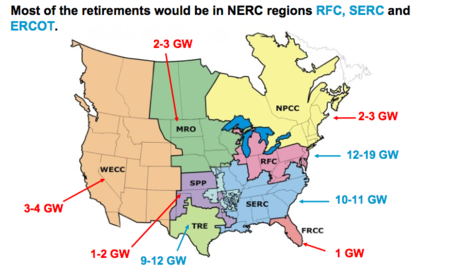Deposing King Coal
Emerging federal air and water quality regulations for coal-fired power plants could lead to a wave of plant closings -- with many of the shutdowns happening across the coal-dependent South.
That's the finding of a study [pdf] released this month by The Brattle Group, an international economics consulting firm. The authors examined the economics for each coal plant in light of new Environmental Protection Agency regulations requiring controls to reduce emissions of sulfur dioxide, nitrogen oxide, particulates and hazardous air pollutants such as mercury, as well as the installation of cooling towers to reduce the use of cooling water.
The study found that the rules are likely to result in over 50,000 megawatts of coal plant retirements nationwide -- about 20 percent of current capacity. The retirements would be especially significant in the South, representing up to 72 percent of all coal plants there. That's illustrated by this map from the study:

Compared to other studies projecting that mostly old and small coal units would be likely to retire, The Brattle Group's analysis finds that about a third of the retirements would be among plants less than 40 years old and larger than 500 MW. Study co-author Metin Celebi says that could result "in significant challenges for the coal industry as a whole."
The transition away from coal is already underway: Earlier this year, Duke Energy announced that it was considering closing seven coal-fired units in the Carolinas, while TVA adopted a plan to close part of its coal-fired fleet. And last year, Progress Energy unveiled a proposal to shutter its 11 remaining coal-fired units across North Carolina that lack desulfurization scrubbers and to build new gas-fired units instead.
One big benefit of the coal-plant closing would be a significant reduction in greenhouse gas pollution. If all of the closing coal plants were replaced by gas-fired plants, carbon dioxide emissions could fall by 150 million tons per year -- about 7 percent of all carbon dioxide emissions from the electric power sector, according to The Brattle Group.
Public health would also benefit from the closures. A report [pdf] released earlier this year by the Clean Air Task Force estimated that particulate pollution from existing coal plants is expected to cause nearly 13,200 deaths in the U.S. this year alone, as well as 9,700 hospitalizations and 20,000 heart attacks per year -- at an annual cost of as much as $100 billion.
In addition, the closures would ease the economic burden that coal plant pollution has on downwind businesses. A new study [pdf] by a former professor and power industry expert found that power plants without state-of-the-art scrubbers are costing other businesses some $6 billion annually. Those costs include higher labor expenses, lost work days, lost productivity and higher insurance costs.
That's the finding of a study [pdf] released this month by The Brattle Group, an international economics consulting firm. The authors examined the economics for each coal plant in light of new Environmental Protection Agency regulations requiring controls to reduce emissions of sulfur dioxide, nitrogen oxide, particulates and hazardous air pollutants such as mercury, as well as the installation of cooling towers to reduce the use of cooling water.
The study found that the rules are likely to result in over 50,000 megawatts of coal plant retirements nationwide -- about 20 percent of current capacity. The retirements would be especially significant in the South, representing up to 72 percent of all coal plants there. That's illustrated by this map from the study:

Compared to other studies projecting that mostly old and small coal units would be likely to retire, The Brattle Group's analysis finds that about a third of the retirements would be among plants less than 40 years old and larger than 500 MW. Study co-author Metin Celebi says that could result "in significant challenges for the coal industry as a whole."
The transition away from coal is already underway: Earlier this year, Duke Energy announced that it was considering closing seven coal-fired units in the Carolinas, while TVA adopted a plan to close part of its coal-fired fleet. And last year, Progress Energy unveiled a proposal to shutter its 11 remaining coal-fired units across North Carolina that lack desulfurization scrubbers and to build new gas-fired units instead.
One big benefit of the coal-plant closing would be a significant reduction in greenhouse gas pollution. If all of the closing coal plants were replaced by gas-fired plants, carbon dioxide emissions could fall by 150 million tons per year -- about 7 percent of all carbon dioxide emissions from the electric power sector, according to The Brattle Group.
Public health would also benefit from the closures. A report [pdf] released earlier this year by the Clean Air Task Force estimated that particulate pollution from existing coal plants is expected to cause nearly 13,200 deaths in the U.S. this year alone, as well as 9,700 hospitalizations and 20,000 heart attacks per year -- at an annual cost of as much as $100 billion.
In addition, the closures would ease the economic burden that coal plant pollution has on downwind businesses. A new study [pdf] by a former professor and power industry expert found that power plants without state-of-the-art scrubbers are costing other businesses some $6 billion annually. Those costs include higher labor expenses, lost work days, lost productivity and higher insurance costs.
Tags
Sue Sturgis
Sue is the former editorial director of Facing South and the Institute for Southern Studies.
